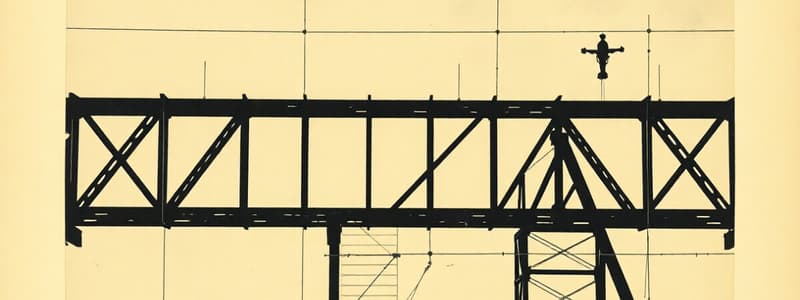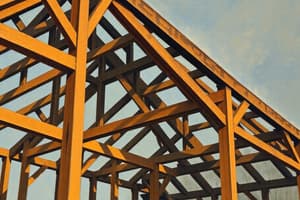Podcast
Questions and Answers
What conditions must be met for a truss section to be analyzed using the method of sections?
What conditions must be met for a truss section to be analyzed using the method of sections?
The section must cut through no more than three members and allow for a clear analysis of forces in the truss.
How is the force in bar HC determined when analyzing the truss?
How is the force in bar HC determined when analyzing the truss?
The force in bar HC is determined by calculating the vertical component Y2 and applying proportions based on similar triangles.
What does the negative sign in the force calculation for bar HG indicate?
What does the negative sign in the force calculation for bar HG indicate?
The negative sign indicates that the bar HG is in compression.
In static equilibrium analysis, what is the significance of choosing a moment center?
In static equilibrium analysis, what is the significance of choosing a moment center?
What are zero bars in truss geometry, and when do they occur?
What are zero bars in truss geometry, and when do they occur?
How do tension and compression forces differ in the context of a truss?
How do tension and compression forces differ in the context of a truss?
Why are truss structures commonly used in engineering applications?
Why are truss structures commonly used in engineering applications?
What role does bracing play in truss systems?
What role does bracing play in truss systems?
What is the significance of the equation ∑Fx = 0 in truss analysis?
What is the significance of the equation ∑Fx = 0 in truss analysis?
How does one determine if a member in a truss is in tension or compression?
How does one determine if a member in a truss is in tension or compression?
Explain how the method of sections helps in analyzing a truss structure.
Explain how the method of sections helps in analyzing a truss structure.
What role do bracing systems play in truss structures?
What role do bracing systems play in truss structures?
What conditions must be satisfied for a structure to be in static equilibrium?
What conditions must be satisfied for a structure to be in static equilibrium?
Why is it important to isolate joints in truss analysis?
Why is it important to isolate joints in truss analysis?
How can you determine the forces in truss members after identifying the support reactions?
How can you determine the forces in truss members after identifying the support reactions?
What is the primary difference between a tied arch and a standard truss?
What is the primary difference between a tied arch and a standard truss?
What condition must be satisfied for a truss to be considered stable and determinate?
What condition must be satisfied for a truss to be considered stable and determinate?
In a truss composed of three bars with no external load, what will be the force in the non-collinear bar?
In a truss composed of three bars with no external load, what will be the force in the non-collinear bar?
What defines the degree of indeterminacy (D) in a truss?
What defines the degree of indeterminacy (D) in a truss?
How can the concept of zero bars assist in analyzing a truss structure?
How can the concept of zero bars assist in analyzing a truss structure?
What is the consequence if $r + b < 2n$ in a truss?
What is the consequence if $r + b < 2n$ in a truss?
Explain the significance of the equilibrium equations $ΣF_x=0$ and $ΣF_y=0$ in truss analysis.
Explain the significance of the equilibrium equations $ΣF_x=0$ and $ΣF_y=0$ in truss analysis.
Describe how the method of joints is applied in analyzing a truss structure.
Describe how the method of joints is applied in analyzing a truss structure.
Why is it important that the restraints in a truss do not create a parallel or concurrent force system?
Why is it important that the restraints in a truss do not create a parallel or concurrent force system?
Flashcards are hidden until you start studying
Study Notes
### Determinacy and Stability
- In a truss, equilibrium equations must satisfy 𝐹𝑥 = 0 𝑎𝑛𝑑 𝐹𝑦 = 0
- The number of equilibrium equations equals 2n where n is the number of joints.
- For a determinate and stable truss: 𝑟 + 𝑏 = 2𝑛
- r represents the number of reactions.
- b represents the number of bars.
- Restraints should not form a parallel or concurrent force system.
- The degree of indeterminacy is found by: D = 𝑟 + 𝑏 − 2𝑛
- If 𝑟 + 𝑏 > 2𝑛 the truss is indeterminate.
- If 𝑟 + 𝑏 < 2𝑛 the truss is unstable.
Zero Bars
- If a joint with two bars has no external load, the forces in both bars equal zero.
- If a joint with three bars, two collinear, has no external load, the force in the non-collinear bar equals zero.
Example 3
- The truss in the example has 4 reactions and is analysed by the method of Joints.
- Joints E and I have two bars with no external load, so those bars are zero bars.
- The two bars connected to joint D are also zero bars.
- Bar CG is also a zero bar.
- Analyzing joints F, C, G, H, A, and B in sequence demonstrates the truss is stable and determinate by the equations of statics.
Section Method
- The method of sections divides a stable truss into two free bodies.
- A section typically cuts three bars since there are three equations of static equilibrium.
Example 2
- The method of sections is used to determine the forces in bars HG and HC.
- A moment center (point a) is chosen at the intersection of forces F1 and F3.
- Force F2 is extended and replaced with its rectangular components, X2 and Y2.
- Similar triangles are used to determine distances.
- The moment of forces about point a is used to solve for Y2 (7.5 kips, tension).
- Y2 is used to calculate X2 (10 kips, tension).
- A moment center at point C is used to determine X1 (90 kips, compression).
- X1 is used to calculate Y1 (22.5 kips, compression).
Studying That Suits You
Use AI to generate personalized quizzes and flashcards to suit your learning preferences.




